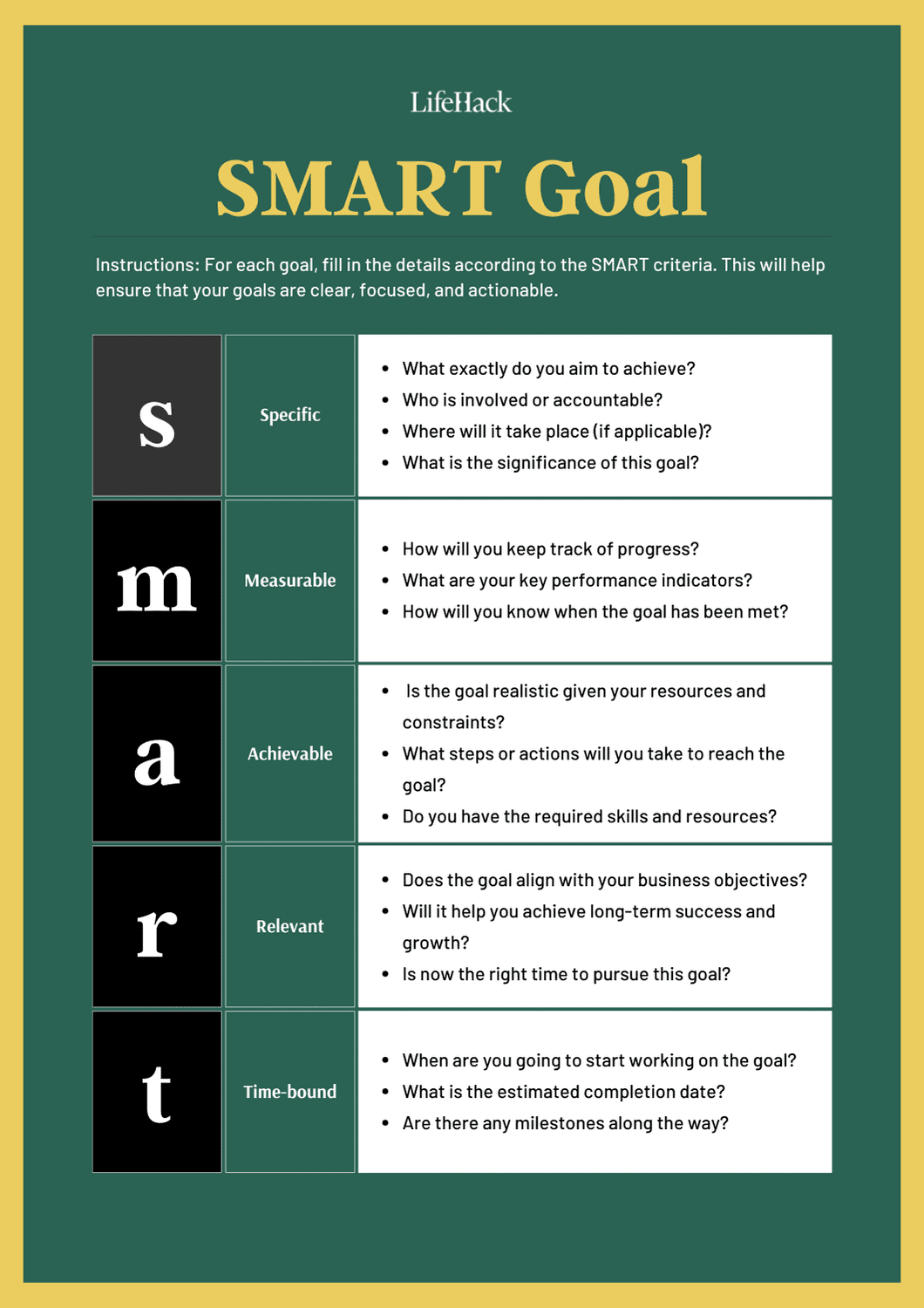I was a track and field runner in school, every year I would sit down with my coach and set a series of goals for the season. Once we had set my goals for the year, we would create a training plan so I could achieve those targets. This helped me answer the main question here: “What are SMART goals?”
Before I got a coach, I used to run aimlessly with no plan, and no target races. More often than not, I would end up injured and find my season-ending after achieving very little.
Once I got a coach, I started winning races that mattered and began enjoying my sport. This annual process taught me from a very early age that goals are important if I want to achieve the things that are valuable to me.
So what exactly are SMART goals? This article will talk about why goals matter, how to use smart goals effectively, and how these goals give you a clear and specific plan that works time and time again.
Table of Contents
What Are SMART Goals?
The foundation of all successfully accomplished goals is the SMART goal. But what is it?
Originally conceived by George T. Doran in a 1981 paper[1], this formula has been used in various forms ever since.
SMART is an acronym for Specific, Measurable, Attainable, Relevant, and Time-bound. It has been used by corporations and individuals to achieve their goals and objectives and is a formula that, on the whole, works well.
The strength of SMART goals is that they set a clear path to achieving goals, and they have a clear time frame in which to achieve them.
Let’s look at the smart goal setting criteria in more detail:
Specific
For a goal to be achievable, it needs to have a very clear outcome. The clearer the goal, the more likely it is you will achieve it.
For example, if you just say “I want to lose weight,” then technically you could achieve your goal just by not eating dinner for one day—you would lose weight that way, even if it were temporary.
You need to have a more specific goal: “I want to lose twenty pounds by the end of this year.”
To ensure your goal is as specific as it can be, consider the Ws:
- Who = who is involved in executing this goal?
- What = what exactly do I want to accomplish?
- Where = if there’s a fixed location, where will it happen?
- When = when should it be done by? (more on deadline under “time-bound”)
- Why = why do I want to achieve this?
Measurable
The only way to know whether or not your goal was successful is to ensure it is measurable. Adding numbers to a goal can help you or your team weigh up whether or not expectations were met and the outcome was triumphant.
Take the example above: “I want to lose twenty pounds by the end of this year.”
It’s measurable, as all you need do is weigh yourself at the beginning of your journey, then deduct twenty pounds from that. Set your new weight target for December 31, then each week weigh yourself to measure progress.
Setting milestone throughout your process can also help you to reassess progress as you go along.
Attainable
It’s great to have big dreams but you want your goals to be within the realms of possibility, so that you have a higher chance of actually accomplishing them.
But that doesn’t mean your goal shouldn’t be challenging. You want your goal to be achievable while at the same time test your skills.
In our example of losing weight, 20 pounds in six months is certainly doable. Your resources could include a gym membership, some at-home weights, or motivation to get outside and run every day.
Relevant
For any goal to be achieved, you need to set relevant goals for your unique life. It has to align with business objectives or with your personal aspirations or else, what’s the point of doing it?
A SMART goal needs to be applicable and important to you, your team, or your overall business agenda. It needs to be able to steer you forward and motivate you to achieve it, which it can if it holds purpose to something you believe in.
If losing weight is doable with the lifestyle you have, and if you believe it will lead to a happier, healthier life, then it is certainly relevant to you. It’s even more relevant if your doctor has pointed out that you need to lose weight to prevent health issues.
Time-bound
The last factor of the SMART goal is time-bound (also known as “timely”). Your goal needs a deadline, because without one, it’s less likely to be accomplished.
A deadline provides a sense of urgency that can motivate you or your team to strive towards the end. The amount of time you allocate should be realistic. Don’t give yourself—or your team—only one week if it takes three weeks to actually complete it. You want to set a challenge but you don’t want to risk over stress or burn out.
In our example of losing twenty pounds, a timeline of six months would be specific, measurable, relevant, and would have a timeline. Furthermore, as you have what you need to achieve that goal, it is attainable—all elements of the formula for SMART goals are included.
Check out these 11 SMART goals examples for inspirations.
How to Make Your SMART Goal Achievable
The problem I have always found with the SMART goal formula is it does not take into account the human factor. We need motivation and a reason for achieving these goals.
For example, if you decide to lose twenty pounds, you are going to spend many months feeling hungry, and unless you possess superhuman mental strength, you are going to give in to the food temptations.
All SMART goals can be distilled down to three words:
- What do you want to achieve?
- Why do you want to achieve it?
- How are you going to achieve it?
When you simplify your goal in this way, achieving it becomes much easier.
1. Visualize What You Want
One way to make your goals achievable is to visualize the end result. When you write out your mission statement, you should be imagining what it will be like once you have achieved the goal.
In our weight loss example, you would close your eyes and imagine walking down from your hotel room in Cancun in December with your towel, sunscreen, sunglasses, and swimwear on. You would imagine walking past all the other sunbathers and the feeling you have, the pride in the way you look and feel.
Try to invoke as many of the five senses as you possibly can.
2. Identify Your “Why”
Once you have made the decision that you want to do this, the next question to ask yourself is, “why?” The more personal your why, the better.
Your why could be, “Because I want to look and feel fantastic by the pool in Cancun.” That is a strong why. If your why is, “Because my doctor told me to lose some weight,” that is not a good why because it’s your doctor’s, not yours.
One way to identify your “why” is to write your mission statement.To help with setting achievable SMART goals, I always ask them to complete the following mission statement:
I will [STATE GOAL CLEARLY] by [DATE YOU WANT TO COMPLETE THE GOAL] because [YOUR WHY].
If you want to write a SMART goal using the weight loss example, your mission statement would be written: “I will lose twenty-pounds by the end of this year because I want to look and feel fantastic in Cancun.”
Never write a mission statement that is full of vague words. The words you use should be simple, direct, and clear.
3. Figure Out Your “How”
Before you can begin to attain your goal, you need to create a list of steps you can take to make it happen.
Write down everything you can think of that will help achieve your goal. It doesn’t matter what order you write these tasks down; what matters is that you write down as many action steps as you can think of.
I always aim for around one hundred small steps. This makes it much easier to assign tasks for each day that not only move you forward on your goal but also keep you focused every day on achieving it.
Once you have your list, you can create a to-do list for the goal and allocate the steps to different days so you create momentum towards a successful outcome.
4. Make a PACT
There is one more part needed to really make sure you achieve the SMART goals you set for yourself, and that is something I call PACT. PACT is another acronym meaning Patience, Action, Consistency, and Time. You need all four of these to achieve your goals.
Patience
Without patience, you will give up. To achieve anything worthwhile requires patience. Success does not happen overnight. Be patient and enjoy the process of stepping a little closer to achieving your goal each day.
Action
If you do not take action on any goal, then even SMART goals won’t be achieved. You need to make sure you remind yourself of your goal and why you want to achieve it each day. Read your mission statement, make an action plan, and then take the necessary action to make sure you move a step closer each day.
Consistency
The action you take each day towards achieving your goal needs to be consistent. You can’t follow your diet program for a week and then have three weeks off. Jim Rohn said it perfectly when he said:
“Success is a few simple disciplines practised every day.”
Time
Of course, you need to allow enough time between where you are today and where you want to be in the future. Be realistic about time, and don’t get disheartened if you miss your deadline. Readjust your timeline if necessary.
SMART Goal Template
For every idea or desire to come to fruition, it needs a plan in place to make it happen. And to get started on a plan, you need to set a goal for it.
The beauty of writing goals according to a SMART goals template is that it can be applied to your personal or professional life.
If it’s your job to establish goals for your team, then you know you have a lot of responsibility weighing on your shoulders. The outcome of whether or not your team accomplishes what’s expected of them can be hugely dependant on the goals you set for them. So, naturally, you want to get it right.
On a personal level, setting goals for yourself is easy, but actually following through with them is the tricky part. According to a study by Mark Murphy about goal setting, participants who vividly described their goals were 1.2 to 1.4 times more likely to successfully achieve their goals.[2] Which goes to show that if you’re clear about your goals, you can have a higher chance of actually accomplishing them.
Adhering to a SMART goals template can help you with writing clear goals. Here’s a SMART goals template that you can download:
Self-Evaluation When Setting SMART Goals
Despite understanding what SMART goals are and how to effectively write them out, some of you will succeed in your goals while some of you will fail.
That is the nature of goals. Despite your best efforts, sometimes you’ll come out short. But that’s okay because this reveals another aspect of goals.
You see, goals help us change in so many ways, and they themselves can change, too. As you work through your goals, you might make adjustments to them. Maybe you need a little more time, or you weren’t expecting other life distractions to dig into your time.
Regardless, here is how you want to approach and evaluate these aspects:
Evaluating Failure
Take failure as a learning opportunity. It’s a chance for you to learn about yourself and your goal-setting strategies. From there, you can take that information and begin to make adjustments before attempting the goal again.
It is essential that if you experience roadblocks or failures, you don’t take them as such. These are challenges and opportunities for growth and further adjustment. The key is to walk away from these aspects with more knowledge than before.
Evaluating Success
While this is a good opportunity to enjoy your rewards, you should also use this opportunity for reflection, perhaps even more than with failure.
Success is great, but that often leads to the question of “what’s next?” And for many people, this is not an easy question to answer.[3] All in all, success can lead to us stagnating, which is dangerous.
That’s not to say we need to be constantly achieving and setting goals. You should certainly be celebrating victories big or small. Not only that, but it’s key that we enjoy the results of our efforts.
However, there comes a point where we need to reflect on that success. What have you gained from that success? What can you do moving forward to achieve more? What do you want to do next?
By asking deeper questions about what you have achieved, you can further develop yourself and narrow down what needs to be focused on next.
The Bottom Line
The key to success is to put everything together. When you connect all of these elements, you create an environment where achieving goals becomes much more attainable.
Whether it’s personal or business goals, when you have a strong personal “why” for your goal, your motivation to keep going stays strong.
Start with your “why,” and then get started on the action steps that will take you all the way to the end.
Reference
| [1] | ^ | George T. Doran: There’s a S.M.A.R.T. way to write management’s goals and objectives |
| [2] | ^ | Forbes: Neuroscience Explains Why You Need To Write Down Your Goals If You Actually Want To Achieve Them |
| [3] | ^ | Tanveer Naseer Leadership: Where Do We Go Next After We Succeed? |















































